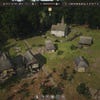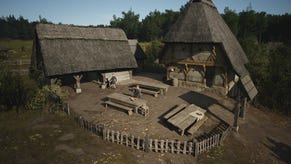Manor Lords’ early access launch is built on solid technical ground, mostly
Mind your manors with this performance and settings guide
My most recent experiences with performance-testing strategy games have been defined by miserable sluggishness and dental drama, so it’s been a relief to find that citybuilding/RTS hybrid Manor Lords is set to launch in a relatively fine state. As an early access game, no less.
Having dug into the latest build’s GPU performance and graphics settings, I have found a few loose strands of technical flax that Manor Lords could do with snipping away. Yet it’s generally in good shape, both for early access and a solo developer project, successfully balancing strong visuals with relatively light hardware demands that should help it run on older PCs (or handhelds like the Steam Deck). Several hours in, the ugliest things I’ve seen are my road layouts.
There’s also support for FSR and DLSS upscaling, the latter doing a particularly excellent job of lifting framerates even higher. Scroll down for my full best settings guide, which you can keep to hand for the early access launch on April 26th, or if you want to know how Manor Lords performs on various graphics cards... uh, also scroll down, just not as far.
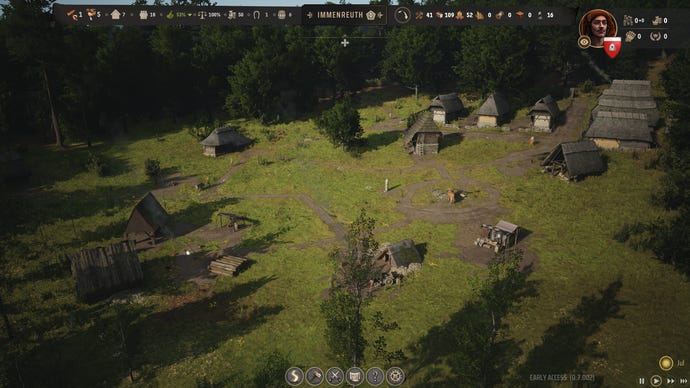
Manor Lords system requirements and PC performance
Just like the Total War series from which its fiefdom vs. fiefdom battles are inspired, Manor Lords avoids making big demands of your PC parts. The minimum spec lists GPUs as humble as the 2GB GeForce GTX 1050, with only 8GB of RAM needed, and even the recommended specs only suggest CPUs and graphics cards that are nearly as old as the bricks in my village well. It’s a small install, too, with no explicit need for an SSD over a hard drive.
Manor Lords minimum PC specs
- OS: Windows 10 (64-bit)
- CPU: Intel Core i5-4590 / AMD FX-Series FX-4350
- RAM: 8GB
- GPU: Nvidia GeForce GTX 1050 / AMD Radeon RX 460 (4 GB)
- DirectX: Version 12
- Storage: 16GB available space
Manor Lords recommended PC specs
- OS: Windows 10 (64-bit)
- CPU: Intel Core i5-6600 / AMD FX-Series FX-9590
- RAM: 12GB
- Graphics: Nvidia GeForce GTX 960 (4 GB) / AMD Radeon™ RX 570 (8 GB)
- DirectX: Version 12
- Storage: 16GB available space
So consigned to history are most of these components that I didn’t actually have any to test, the closest being a 4GB version of the RX 570 that I quickly found was broken (RIP). I did have a GTX 1050 Ti, though, so plugged it into the RPS test rig and saw it cruise to 80fps at native 1080p with Low settings.
That, it should be noted, is with the help of a very much above-spec Intel Core i5-11600K and 16GB of RAM, but it bodes well nonetheless. The GTX 1050 Ti could also handle Medium settings, averaging 46fps, though that comes with a noticeable drop in motion smoothness.
Taking the GPU up a level, while still on 1080p, the GTX 1060 produced 72fps on Medium and 58fps on High. Again, good results for such long-in-the-tooth hardware. And a more modern low-end card, Intel’s Arc A750, had no trouble achieving 65fps on Ultra settings and 97fps on High. The GTX 1060’s youngest descendent, the RTX 4060, also scored 83fps on Ultra, though there’s no DLSS 3 support to add some AI-generated frames on top of that.
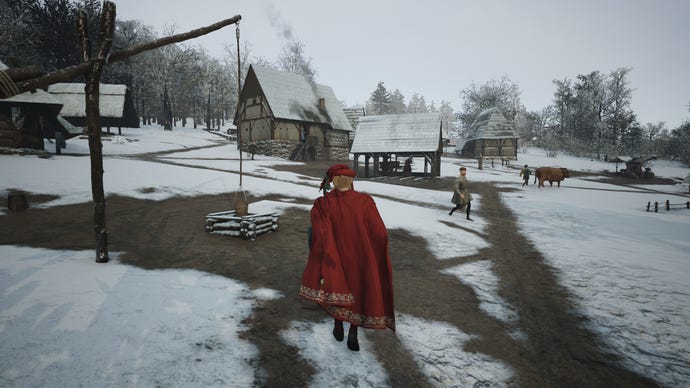
Looking to 1440p, the RTX 4060 could still keep its cool, averaging 55fps on Ultra – and bumping that all the way up to 84fps by switching TAA for DLSS upscaling on Quality. This addition also improved the RTX 3070’s Ultra/440p performance from 83fps to 112fps, and the RTX 4070 Ti’s from 126fps to 170fps, all while beating TAA on sharpness and visual detailing.
Upscaling – be it DLSS or FSR – is even more useful on ultrawide resolutions, which Manor Lords appears to ably accommodate, as well as 4K. Here, the RTX 4070 Ti could do 70fps on Ultra with native TAA, but Quality DLSS punched that up to 122fps. The RTX 4090, Nvidia’s most 4Kish of all their 4K GPUs, also turned a 125fps result with TAA into 168fps with Quality DLSS.
Manor Lords, therefore, does a jolly good job of both opening itself up to entry-level PCs while letting premium rigs off the leash. That goes for non-desktops, too. At its native 1080p, my RTX 4050-powered MSI Thin GF63 gaming laptop could run High settings at 84fps, or 126fps with DLSS on Quality. Ultra was playable too, averaging 48fps with TAA and 70fps with DLSS Quality.
Meanwhile, the Steam Deck can’t quite deal with a full set of High settings, but turning everything down to Medium was enough to get it within the 30-40fps range. It’s still not the smoothest citybuilding experience you can have on the Deck, though that’s mainly for non-performance reasons: Manor Lords’ gamepad support is functional but not especially fleshed out, relying heavily on the Deck’s right trackpad and failing to replace on-screen mouse and keyboard prompts with face button or thumsticks equivalents. It kinda works, but you’ll need to engage in some trial and error to figure out the more complex commands.

Maybe handheld and controller support will be among the changes that Manor Lords makes in its early access phase. Right now, it seems fairly solid – not at all the kind of early access game that will crash on the spot upon an errant mouse swish – though I’m hoping that means that the issues that do exist can be identified and stamped out quicker. For one, there’s some nasty stuttering when you load up a save. It’s not sustained beyond that, hence why I haven’t moaned about it until about 900 words into this piece, but some polish there would be appreciated.
Ironically, the settings menu itself could also use some tightening up. You probably shouldn’t be able to select DLSS on non-RTX graphics cards, as you can now – it doesn’t do anything, except perhaps give Radeon owners false hope – and I’ve noticed that some graphics options occasionally stop highlighting which precise setting is enabled. The bounced light approximation option also has a habit of switching back to Ultra immediately after you’ve lowered it, meaning that for now, it’s effectively impossible to decrease or switch off.
That needs fixing, but still, I don’t think there’s anything too worrying here. Manor Lords evidently runs well on weak kit even with maximum light bounciness, and with the right settings, it’s possible to stay mostly stutter-free beyond the initial burst.
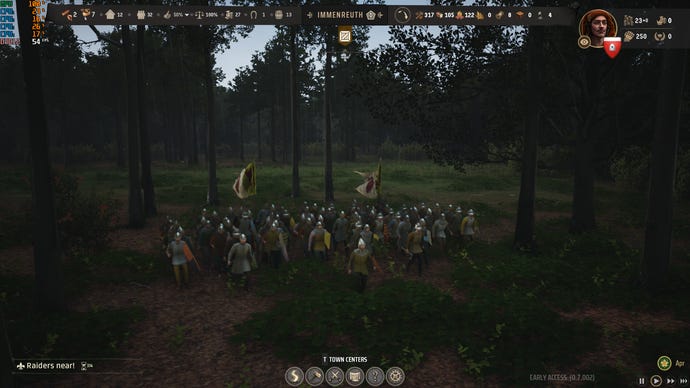
Manor Lords best settings guide
Most reasonably up-to-date PCs can, in all likelihood, get good framerates out of Manor Lords on its highest settings. The really lordly thing to do, however, would be to sacrifice a few quality options in exchange for a disproportionately bountiful improvement to performance. Like if framerates were firewood, and foliage quality was the peasant family I casually yanked from their berry foraging business to spend eighteen hours a day chopping logs. Good of the many, innit.
Making these cuts is easier knowing that, unless you’re absolutely scraping the bottom of the minimum spec barrel, you don’t really need to drop as far as Low. Just a handful of Medium settings can seriously speed up Manor Lords, as I found when lowering each one individually to see which are the most performance-determinant.
For these tests, I used an RTX 4060 at 1080p, starting off with full Ultra settings and anti-aliasing set to TAA. That setup averaged 83fps, so any options that significantly improve that can be considered for tweaking. Anything else, you can likely leave on Ultra, except perhaps on the very weakest hardware.
Anti-aliasing: For native rez play, FXAA is an unusually attractive alternative to TAA. With it, I averaged 84fps, so it’s only a teensy bit faster, but then it also doesn’t blur out fine details to the extent that TAA does.
Of course, for 1440p and above, upscaling is even better. FSR on Quality will suffice for non-RTX GPUs, sending performance up to 96fps on its Quality mode, but Nvidia’s DLSS is both the fastest (with 108fps on Quality) and the best-looking.
Dynamic DLSS: Toggling this allows DLSS to automatically switch between different quality modes, depending on whether the framerate is rising or dipping. It can even enable DLAA, which is basically non-upscaled, native-rez anti-aliasing, during periods of smooth running. This was presumably in use for some of my benchmark run, as I averaged 99fps – slower than with Quality DLSS permanently on.
As in Horizon Forbidden West, Dynamic DLSS is pretty good at masking its rendering resolution changes, though to be honest, Quality DLSS looks so good I’m not sure it’s worth the occasional spells of DLAA.
3D Resolution scale: Leave this on 100%. Manor Lords usually runs well enough that you don’t need to reduce the 3D visuals’ resolution, and if you do, using an upscaler at least tries to replicate the look of native rendering.
Sharpening: This can be ignored as well. Adding this sharpening effect hurts Manor Lords’ visuals more than it helps, with even the Medium setting producing an artificial, heavily processed look.
Shader quality: I didn’t get a tangible performance improvement from lowering this on my RTX 4060, though there was a small gain to be had from dropping to Low on the Steam Deck. In other words, keep it high if you’ve got a decent desktop GPU, but consider lowering it if you’re playing fast and loose with the system requirements.
Shadow quality: Worth lowering, this. Medium shadows only look the teensiest bit less detailed than on Ultra, but got my RTX 4060 up to 93fps in a single click.
Postprocess quality: Dropping this had no effect on performance, as far as I could measure.
Bounced light approximation: As mentioned, this setting appears to be bugged at the time of writing, consistently and immediately setting itself to Ultra. Hope you like light rays being simulated with a higher degree of accuracy.
Volumetric clouds: For some reason, disabling these reduced performance, dropping to 81fps. Best leave them on.
Terrain texture resolution: Surprisingly, this also failed to move the performance dial when dropping from Ultra to Medium. Stick to Ultra, I guess!
View distance: The RTX 4060 scooted up to 85fps with view distance on Medium, though that’s not really worth it, given the difference is easily noticeable when zoomed in. Or when pottering about your village in third-person, as Manor Lords lets you do. Go with Ultra to minimise that pop-in.
Grass density: Medium netted me 91fps here, though the loss in quality is easily spotted. High is arguably a better compromise, still delivering a framerate boost (up to 88fps) while still maintaining that rural detail.
Grass distance: This, on the other hand, is one for the Medium pile. High looks a little better but Medium is faster, averaging 87fps to High’s 85fps.
Foliage quality: Lower this to Medium as well. The quality difference from Ultra is easily small enough that the performance gain, up to 88fps in the RTX 4060’s case, justifies it.
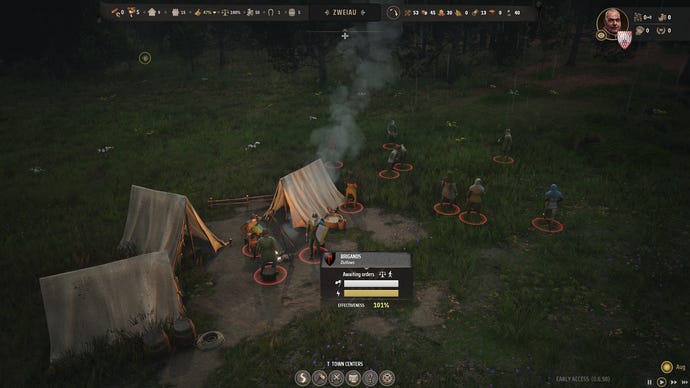
I was worried it would be masses of battle-ready NPCs that would cause Manor Lords’s biggest performance drops, but it turns out it was those dastardly trees all along. Its best settings combination, therefore, focuses heavily on bringing down the impact of framerate-sapping foliage:
- Anti-aliasing: FXAA (native resolution only), or DLSS/FSR on Quality
- Shadow quality: Medium
- Grass density: High
- Grass distance: Medium
- Foliage quality: Medium
- Everything else: Ultra
Still on 1080p, these settings (including FXAA) sent my RTX 4060 rocketing from 83fps to 137fps – a 65% improvement, and without a Low setting in sight. Quality DLSS, with Dynamic DLSS left disabled, turned that into a 110% improvement by scoring 174fps. Not bad, Manor Lords, not bad at all.
I also tested these settings on the GTX 1050 Ti, averaging 43fps, or about the same as using the full suite of Medium settings. That bumped up to 50fps with shader quality on Low, mind, so that’s another change worth making on lower-end PCs Still, that’s literally the only setting that needs to drop all the way to its respective minimum.


